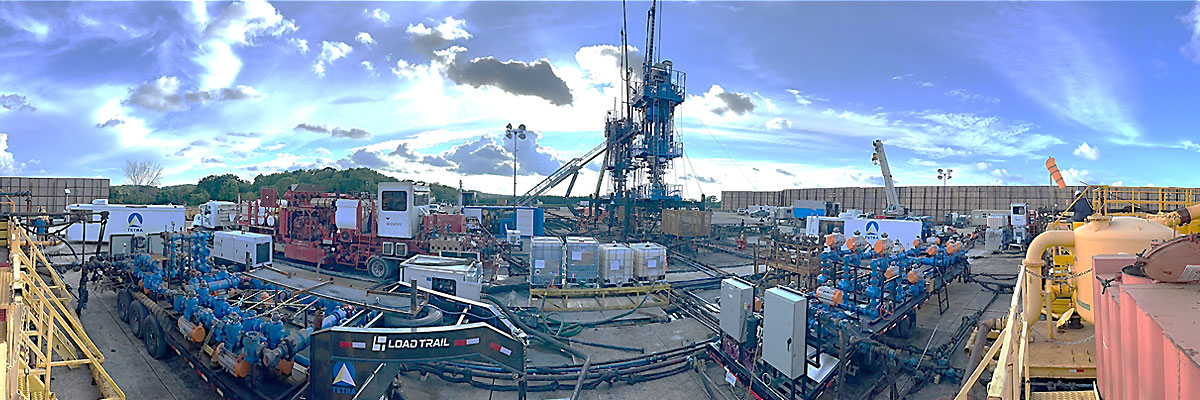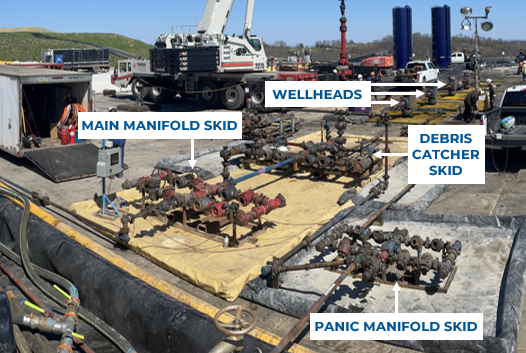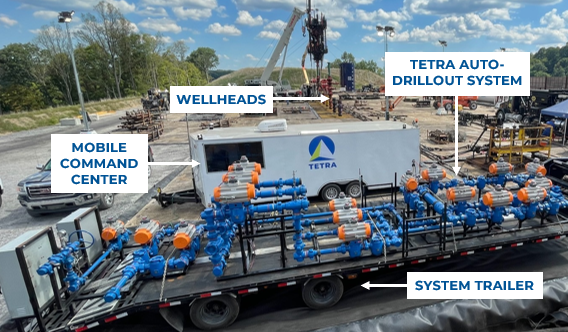Ett mer effektivt sätt att städa bort skräp från pluggar
Av Bram Alackness | Product Line Supervisor | 14 mars 2025

Att rensa bort skräp från pluggar och fracsand i borrhålet kan vara besvärligt och innebära betydande risker för arbetarnas säkerhet, produktionen och miljön. I en typisk horisontell brunn där den vanliga plug-and-perf-metoden används sätts flera bryggpluggar med jämna mellanrum för att isolera de olika laterala stegen. När den hydrauliska spräckningsprocessen är klar borras de pluggar som sitter i borrhålet vanligtvis ut med hjälp av antingen en enhet för spiralrör eller en hydraulisk kompletteringsenhet. Genom att avlägsna dessa pluggar öppnas en öppen väg för kolväten att färdas från formationen upp genom borrhålet. Borrningsprocessen kräver noggrann samordning mellan de olika servicebolagen på plats, i synnerhet mellan återföringsbolaget (TETRA) och riggbolaget. Under borrningsfasen måste en konstant cirkulation av vätska in och ut ur borrhålet upprätthållas samtidigt som pluggrest och fracsand rensas bort. Om denna operation inte utförs på rätt sätt kan en ansamling av skräp i borrhålet leda till problem som att röret fastnar och att man förlorar kontrollen över borrhålet[*].
Konventionell utrensning
Ett konventionellt borrpaket består i allmänhet av tre utrustningsskidor - huvudgrenröret, ett reservgrenrör för "panik" och en skräpuppsamlare - som alla måste flyttas på plats med gaffeltruck och kopplas samman med högtrycksflödesledningar. Drift och service av dessa system kräver minst två personer, vilket innebär att ventiler ofta måste manövreras manuellt och filterskärmar tas bort. Dessa specifika arbetsuppgifter kräver att medarbetarna ständigt kliver över och sträcker sig runt högtrycksflödesledningar med ett tryck på mellan 1 000 och 3 000 PSI. Den manuella processen utsätter inte bara medarbetarna för potentiell tryckavlastning, utan ökar också risken för spill som kan skada den omedelbara miljön och stoppa verksamheten.

Automatiserad rensning
TETRA insåg farorna och riskerna med konventionella system och utvecklade branschens första system för automatisk borrning, en revolutionerande totallösning med alla nödvändiga komponenter på en enda 8 x 40 fot trailermonterad skid som automatiskt spolar bort pluggar och sand under borrningen.
TETRA Auto-Drillout System, som är utformat för att bättre hantera trycket i borrhålet och för säkrare drift, minskar risken för kroppsskador genom att kraftigt reducera behovet av att personal på plats manuellt vrider ventiler och tar bort och byter ut skräpuppsamlingsgaller. Systemet drivs från en trailer med en mobil kommandocentral och minskar också avsevärt exponeringen för högtryckszoner och potentiellt instängt tryck. Med en egenutvecklad spolningsprocess som förhindrar uppvällning från formationen ger systemet en grundlig rensning av skräp och sand, vilket minskar risken för att arbetssträngar fastnar och för icke-produktiv tid (NPT).

Enheten är lätt att transportera och sätta på plats, har ett litet fotavtryck och kräver lite underhåll för att undvika kostsamma driftstopp. Den helt integrerade rördragningen omfattar en skräpuppsamlare med automatisk spolsekvensering, ett grenrörssystem med flera segment och ett integrerat panikgrenrör. Alla dessa komponenter är kopplade till en programmerbar logisk styrenhet med anslutningsmöjligheter för fjärrövervakning och fjärrstyrning. Användarna kan komma åt kontrollpanelen från en mobil enhet för att övervaka och styra driften - en funktion som är särskilt fördelaktig när man måste göra justeringar när man är borta från arbetsplatsen. Det smarta systemet upprätthåller också historiska dataloggar och registrerar datapunkter som tryck, ventilaktiveringar, larm och tanknivåer.
Manuell siktdragning vs. automatiserad spolning
En rensning av ett konventionellt paket kräver normalt minst två personer och cirka fyra minuter för varje spolcykel. De manuella stegen är: avleda flödet, isolera pipan, avlufta trycket, avlägsna silen från systemet, rensa silen, återinsätta silen och återställa flödet till den nyligen rensade ledningen. Den manuella driften utsätter arbetarna för risk för hand- eller ryggskador samt risk för potentiellt instängt tryck.
För att utföra service på varje cykel i ett konventionellt borrsystem krävs minst två arbetare som utför flera manuella steg som tar cirka fyra minuter att slutföra, samtidigt som arbetarna utsätts för risken att skada händer eller rygg samt för risken med potentiellt instängt tryck.TETRA Auto-Drillout System kräver däremot endast en person för att användas och utför varje rensningscykel på cirka 40 sekunder. De automatiserade stegen är:
[1] En givare känner av en tryckskillnad som indikerar förekomsten av skräp.
[2] Flödet avleds automatiskt från den primära till den sekundära ledningen.
[3] Huvudflödesledningen nedströms fördelaren stängs och avleder tillfälligt flödet för att spola bort skräp från skräpuppsamlingsskärmen.
[4] När spolcykeln är klar återgår flödet automatiskt från sekundär- till primärledningen.
Fallstudie 1: 40% minskning av riggningsarbetet
TETRA Auto-Drillout System, som först sattes in i Appalacherna sommaren 2022, användes vid 13 okonventionella gaskällor. Under fyra månader av incidentfri drift rensade enheten mer än 2 300 pluggar utan att behöva dra ut en enda skärm och utan någon icke-produktiv tid. När det gäller det mätbara värdet för operatören minskade systemet totalt sett tiden för upp- och nedriggning med 40%, riskexponeringen med 33% och slitaget på systemkomponenterna med 65%, vilket gav en betydande minskning av driftskostnaderna och förbättrad säkerhet.
Fallstudie 2: Över 15 000 pluggar rengjorda
Samma operatör beställde återigen användning av TETRA Auto-Drillout System i Appalacherna. Under cirka 30 månader utförde systemet service på 178 brunnar och rensade totalt 15.425 pluggar, utan att man behövde dra ut och rensa en enda skräpuppsamlingsskärm och utan att det uppstod någon icke-produktiv tid eller några HMS-incidenter.
TETRA-systemet sköts säkert från den mobila kommandocentralens släpvagn och eliminerade manuell styrning av ventiler och dragning av skräpuppsamlingsskärmar. När det gäller effektiviteten förbättrade systemet tryckhanteringen i borrhålet under borrningen genom att möjliggöra förprogrammerad ventilsekvensering och bibehålla konsekventa tryck och flödeshastigheter utan stora svängningar när flödet växlar mellan de två linjerna i det dubbla systemet.
I slutändan minskade TETRA Auto-Drillout System avsevärt operatörens exponering för säkerhets- och miljörisker samt antalet anställda på plats, vilket gav ett exceptionellt värde för deras gasbrunnsutveckling.
[*] Haithem Trabelsi, et al (2021), "Bridge Plug Drillouts Cleaning Practices: An Overview", Natural Resources, vol. 12, nr 2, s. 19-33, februari 2021.


